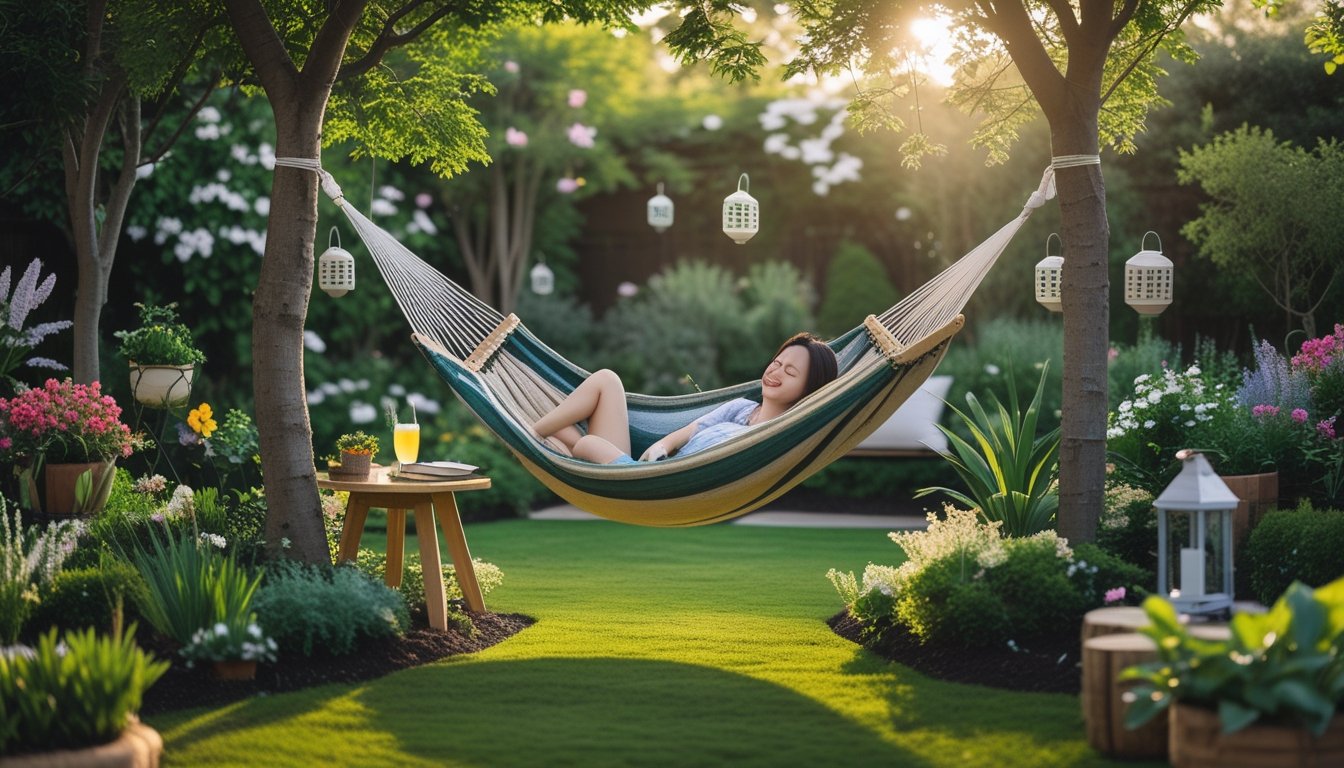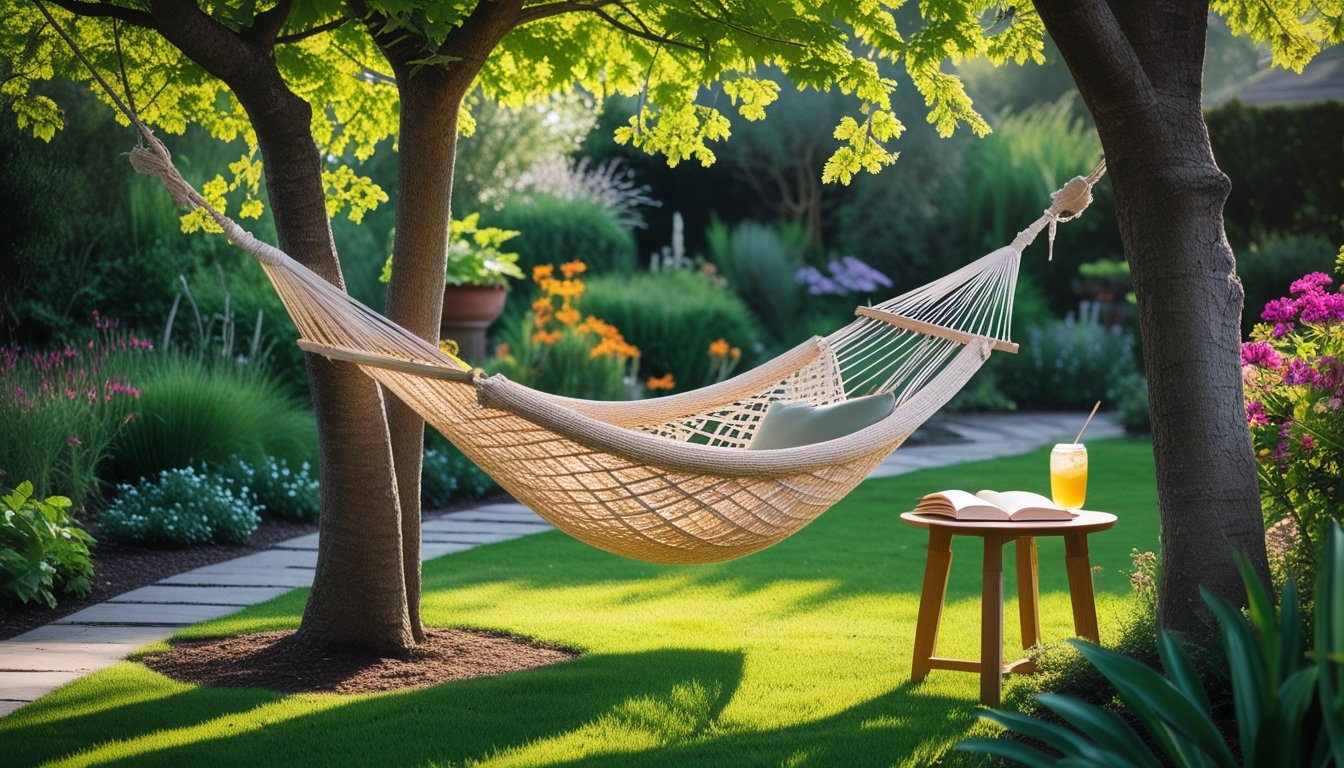Late updated: 12 May 2025 15:05
Written by: James Whitaker
Exploring Unique Garden Hammock Resting Concepts: Innovative Ways to Relax Outdoors
Exploring the world of garden hammocks opens up a realm of soothing possibilities within our outdoor spaces. Whether you're seeking a serene spot to unwind or a cosy corner to enjoy a book, unique hammock concepts can transform your garden into a restful haven. The versatility of hammocks allows for creative installations that cater to various styles and preferences.

In our exploration, we look into inspiring ideas to maximise relaxation in your garden. From sleek, minimalist designs to elaborate and luxurious arrangements, we aim to provide insights that suit every type of outdoor space. Let's journey through the options, considering comfort and aesthetics, ensuring a perfect blend for your personal oasis.
Discovering the ideal hammock starts with understanding its potential to enhance our lifestyle. By integrating distinct elements and innovative setups, we can elevate our garden hammocks from ordinary to extraordinary. Join us as we delve into these restful concepts and uncover ways to enrich our leisure time.
Key Takeaways
- Unique hammock ideas redefine outdoor relaxation.
- Incorporate design elements to boost comfort.
- Address common queries for informed choices.
Innovative Garden Hammock Resting Concepts
Exploring unique placements, combining hammocks with water features, and integrating fire pit setups can dramatically enhance any garden space. This section focuses on creative ways to elevate the tranquillity and functionality of your outdoor areas through innovative hammock concepts.
Creative Placement for Outdoor Hammocks
Positioning a hammock strategically can transform an ordinary yard into a serene outdoor retreat. We recommend hanging hammocks between sturdy trees or using standalone frames near flower beds for a touch of nature. Using pergolas or specially designed hammock stands adds flexibility in placement, allowing us to enhance shaded spots or highlight garden focal points. A thoughtful hammock placement invites relaxation and creates a unique outdoor room, perfect for leisurely afternoons.
Integrating Hammocks with Water Features
Incorporating water features near hammocks can elevate the sense of peace in a garden setting. Placing a hammock next to a waterfall or small pond introduces soothing sounds and visual appeal, creating a calming oasis. For a more contemporary design, we could integrate a hammock over a shallow water feature, combining modern aesthetics with comfort. The gentle trickle of water provides a natural soundtrack, making it an ideal spot for unwinding.
Fire Pit and Hammock Combinations
Combining hammocks with fire pits adds a cosy element to any outdoor space. By situating hammocks around the perimeter of a fire pit, we create an inviting area perfect for evening gatherings. Round fire pits work exceptionally well, allowing hammocks to encircle the warmth, fostering connection and conversation. Adding soft lighting and cushions can further enhance the ambience, offering a delightful mix of comfort and warmth for cool evenings.
Double Hammock Setups for Outdoor Rooms
Doubling up on hammocks transforms garden areas into luxurious outdoor rooms. Using two hammocks side by side or at right angles can accommodate multiple people, encouraging shared moments of leisure. This setup is particularly beneficial for families or social gatherings, allowing us to enjoy the garden experience together. Opting for matching or complementary hammock designs can strengthen the visual appeal, grounding the space as a cohesive whole.
Enhancing Your Hammock Experience

Transforming your garden into a haven of relaxation requires more than just a hammock. Our focus today is on creating a soothing environment, capturing memorable moments in photos and videos, and inspiring camping-style setups to enhance your hammock experience.
Creating an Outdoor Oasis for Unwinding
To create a perfect outdoor oasis, think about incorporating natural elements like stones, plants, and water features. These elements contribute to a serene ambiance, ideal for unwinding after a hectic day. Strategically placing a sound system can add the gentle sound of nature, further setting the mood.
Moreover, landscape lighting can make your garden more inviting, extending your hammock relaxation into the evening. Experiment with hanging lanterns or solar-powered lights to illuminate paths and the area around your hammock.
Capturing Your Relaxation: Photos and Videos
Nowadays, capturing relaxation moments through photos and videos is popular. We can use our smartphones to take high-quality images and videos of our hammock setup. Consider angles that highlight the hammock within the broader garden landscape.
Utilise unique perspectives for creative shots. For instance, from directly above using a drone, or from the ground level capturing the hammock and surrounding environment. When making videos, including nature sounds adds a layer of immersion.
Camping-Style Hammock Ideas
For those who enjoy camping, incorporating camping principles can enhance your garden hammock setup. Think of shelter-like structures, much like a tent, to shield against weather.
A hammock stand mimics the rustic feel of camping. Choose materials like wood for a natural aesthetic. Additionally, try out compact camping hammocks which can be portable and versatile. These are ideal for those who wish to switch between garden and outdoor camping settings for varied experiences.
Frequently Asked Questions

In this section, we answer common inquiries regarding garden hammocks, touching on design, space management, material choices, accessories, weather impacts, and safety.
What innovative designs are available for garden hammocks?
Garden hammocks now come in a variety of innovative designs, including multi-functional options that can transform into seating or lounging areas. Some feature built-in canopies for sun protection, while others integrate stylish frames or colourful patterns to enhance garden aesthetics.
How can one incorporate a hammock into a small garden space effectively?
In small gardens, hammocks can be mounted using compact, freestanding frames or hung from existing structures like pergolas. By selecting a lightweight, foldable hammock, we maximise space and ensure easy storage. Vertical garden elements can also create a dynamic backdrop for the hammock area.
What materials offer both comfort and durability for outdoor hammocks?
Materials such as cotton, polyester, and weather-resistant synthetics provide comfort and durability. Cotton offers a soft touch, while polyester is known for its resistance to moisture and UV rays. Blends often combine these benefits for an ideal balance in outdoor settings.
What are some creative ways to accessorise a garden hammock?
Accessorising a garden hammock can enhance comfort and style. Consider adding cushions, throws, or a side table for convenience. Solar-powered lights or lanterns can create an inviting atmosphere in the evening. Mosquito nets are also useful for a more pleasant resting experience.
How do weather conditions affect the choice of hammock for garden rest areas?
Weather plays a significant role in selecting a hammock. In rainy climates, water-resistant materials are essential. For sunnier areas, UV-protected fabrics prolong the lifespan of the hammock. Removable, washable covers can handle varying weather, ensuring long-term enjoyment.
What safety considerations should one keep in mind when installing a garden hammock?
Safety is paramount when installing garden hammocks. We recommend securing attachments to sturdy structures and regularly inspecting for wear. Setting up at an appropriate height, usually 45-60 cm off the ground, minimises the risk of falls. Always follow manufacturer guidelines for safe usage.
